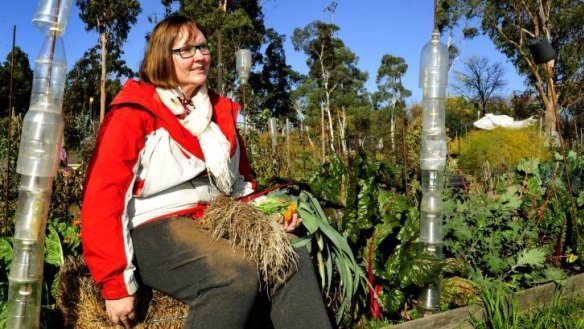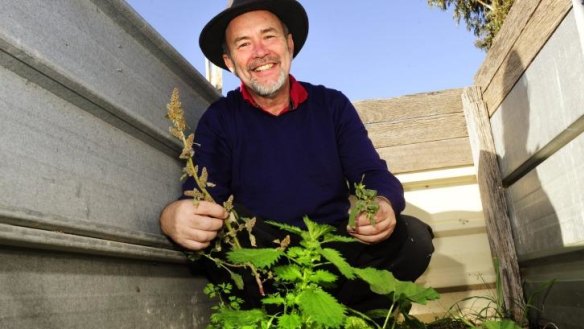Patricia Georgee, Richard Horobin reap rewards from Cotter plots in Canberra

There is a one-litre bucket of pesto in Patricia Georgee's fridge in Curtin. It was made from her basil that had still not been hit by frost in May. Patricia and her husband, Richard Horobin, have 60 kilograms of pumpkins stored in their shed. At present, they are using seeds in a fragrant spiced Indian vegetable and red lentil soup, which they found in an online recipe by Sarah Tuck in New Zealand (dish.co.nz). The soup contains cumin, turmeric, ginger, garam masala and a hint of chilli with lots of chopped pumpkin, onion, sweet potato, waxy potato, carrot, vegetable stock, coconut cream and natural yoghurt. It is served with naan or roti.
The couple has been harvesting crops from plots at the Cotter organic community garden where Patricia has just vigorously pulled a pair of leeks and swiss chard to go in the evening's stir fry. Their plot is part of the oldest COGS (Canberra Organic Growers Society) community garden in the ACT, and was started by the Cotter Road group more than 30 years ago. It is located next to the Cotter plots that were established by Canberra Parks & Gardens in the mid-1960s for trialling trees. The COGS garden moved to the far western side of the tree plantings 26 years ago.
Richard came to Canberra from Perth in 1976 to study at the ANU and Patricia came in 1987 from Adelaide. She grew up in Townsville where "everything grew," including a capsicum plant from a seed which fostered her lifelong interest in horticulture. In their home garden the couple grows brassicas, herbs and a multi-graft plum tree, but after an extension to their house took up backyard gardening space six years ago, they joined Cotter COGS.

Patricia calls the site the wild west. On our visit a wicked wind was blowing but it was too early to hear the lions roaring at the National Zoo on the other side of the Molonglo, as they do most evenings. There are no possums at Cotter COGS but foxes, hares, ducks and snakes are present. Equestrian grounds surround the garden plots and the hay brings mice and weed seeds but it also contributes to manure to enrich the soil.
Among the couple's recent crops of zucchini, beetroot and capsicums, was corn. Unfortunately, it was as much admired by rats and mice as it was by themselves. More recently, they planted rows of garlic from the farmers' market and sowed a green manure crop. (For readers in the NewActon area, there is a thickly sown half bed of green manure germinating in May but, on a recent visit, friends and I watched birds enjoying their "lunch," devouring the tiny green cotyledons, rather than popping in to A. Baker as humans do.)
Patricia and Richard eat swiss chard all year but don't have to plant it, no one does at the Cotter as it self-seeds everywhere. Patricia made nettle soup a couple of years ago and the internet told her how wonderful it would be. Not so, in her opinion.
Edible weeds or wild herbs are both a treat and a terror. In my garden, lemon balm has to be pulled out by the armful and recently introduced perennial rocket, given to me by a kitchen gardener, sees me weeding it out every week, as it flings itself among more desirable edibles, crowding out germinating broad beans and snap peas.
The Cotter gardens' convenor, Ann Smith, encourages edible weeds in her compost heap. Richard showed us the stinging nettles, mallow, amaranth and 'Salad Bowl,' a weedy lettuce variety. It can be harvested a few frilly leaves at a time or the whole plant pulled with its root. These can be placed in a glass of water and eaten over a few days. 'Salad Bowl" does not store in the fridge crisper.
During warm weather, there is purslane or pigweed (Portulaca oleracea) and Choku Bai Jo farmers outlet is selling a large-leafed variety of it grown in Picton. Pigweed is common in gardens with its succulent leaves and thick juicy stems. An ancient food, it was eaten in many countries, with a cultivated form being described in Paris in 1536. The thousands of pin-prick sized seeds it produces were eaten by Aboriginal people.
Ann Smith also grows goosefoot (Chenopodium album) which she turns into a delicious umami Korean side dish but even she says, "there's a point beyond which you'd need to be desperate to go picking apart from the small esculent parts of an edible plant."
Susan Parsons is a Canberra writer.
Restaurant reviews, news and the hottest openings served to your inbox.
Sign up